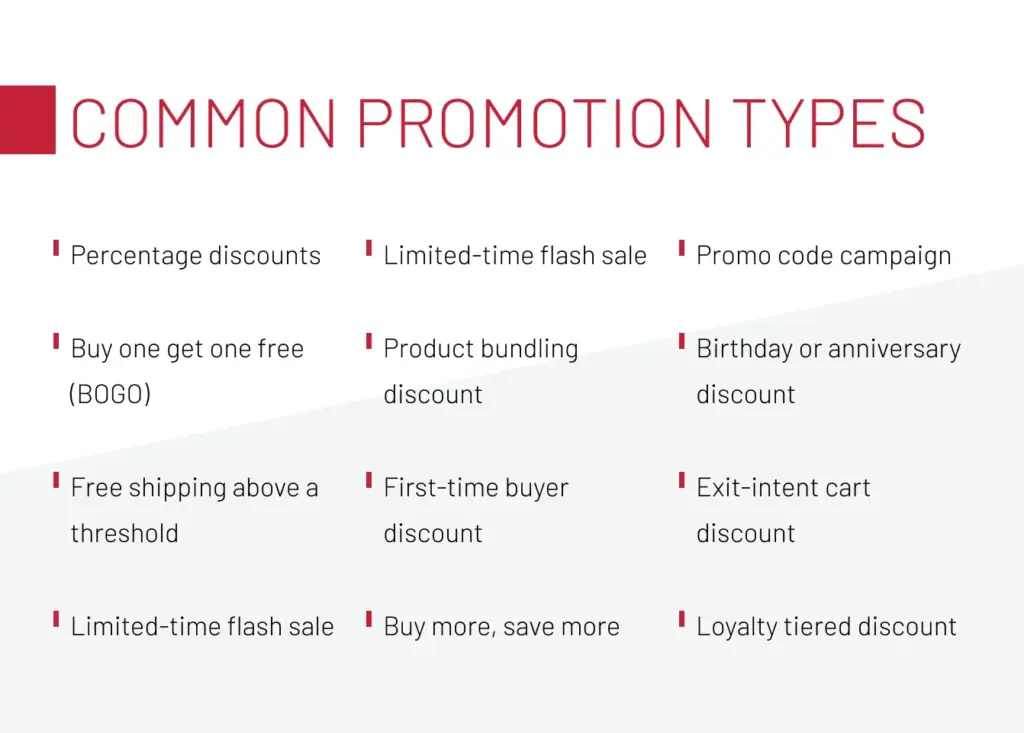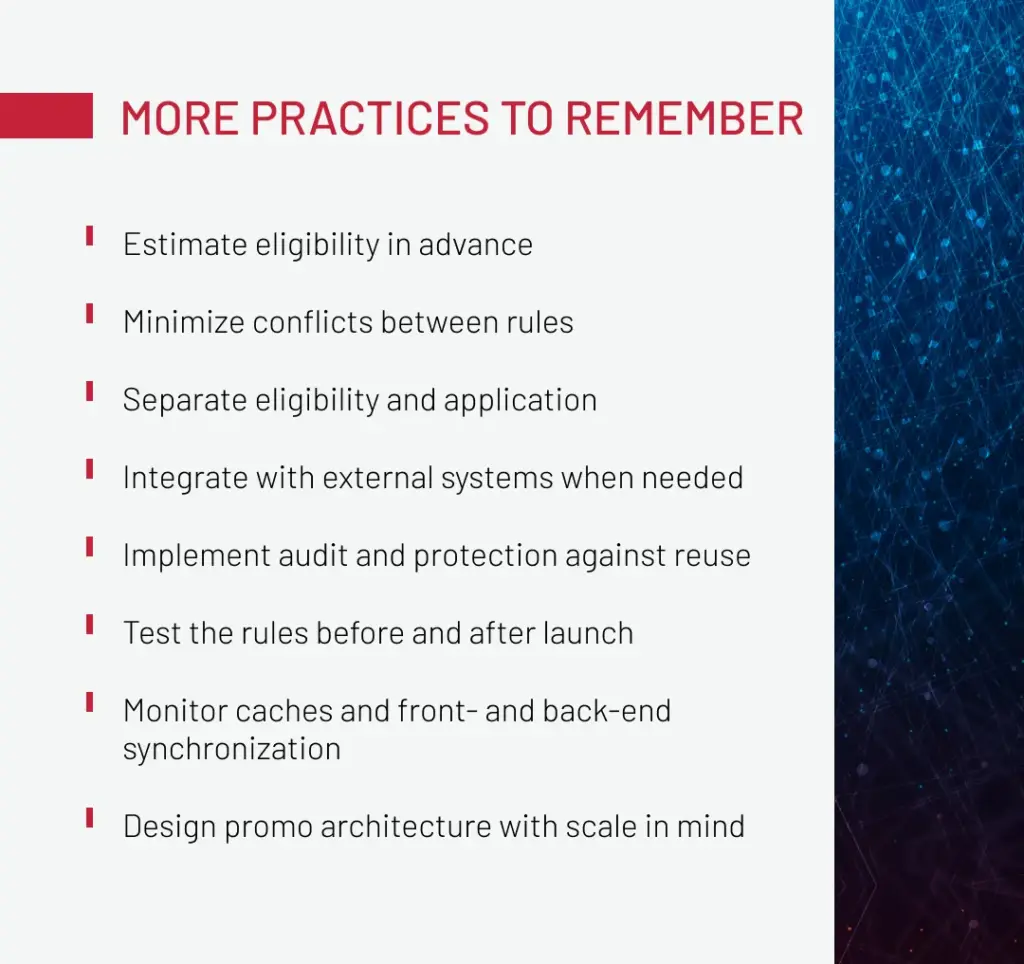10+ Technical Best Practices for Working with Promotions

Promotions are a staple of any ecommerce business strategy. The larger the store, the more complex and frequent these campaigns become. But the thing is that promotions aren’t just about toggling a few parameters. Behind every coupon or discount code is a business logic that needs to be smart, scalable, and deeply integrated with the platform’s architecture.
And not every platform is built to handle promotional campaign complexity. On SAP Commerce Cloud, for example, standard promotion features quickly hit their limits. What starts as a simple “10% off” can evolve into a tangled web of rules, priorities, and caching challenges ecommerce websites have to deal with.
In this article, we’ll break down the technical realities of implementing ecommerce promotions at scale. Drawing from Expert Soft’s experience in SAP Commerce Cloud, we’ll focus on practices that are suitable for this platform, while still relevant to any high-load ecommerce site.
Quick Tips for Busy People
No time to read it all? Here’s a fast, tactical summary of the key practices that make the best ecommerce promotions actually work at scale.
- Pre-calculate eligibility in background jobs to reduce latency during cart and checkout sessions.
- Tag users in advance (e.g., via cronjob) to simplify complex eligibility logic inside Drools.
- Ensure Solr, CMS, and promotion rules are time-synced for smooth flash sale activation and expiration.
- Avoid rule overlap by assigning clear priorities and scoping by category, user type, or channel.
- Keep eligibility and discount code logic separate to improve maintainability and system performance.
- Use cautious cache settings for guest sessions and short-lived or dynamic promotional rules.
- Validate BOGO gift availability in real time to avoid overselling and fulfillment issues.
- In B2B carts, calculate free shipping eligibility per shipment group, not across the entire order.
- Log all promotion redemptions and enforce TTL and single-use to prevent misuse.
- Build a modular promotion framework from day one: avoid patchwork logic as rules grow.
Let’s unpack these ecommerce promotions’ best practices in more detail.
Technical Specifics of Common Promotion Types
Online promotions may look simple on the surface, but all types of ecommerce promotions come with their technical nuances, requiring specific promotional strategies. In this section, we walk through the discount types most commonly used by ecommerce brands — ones developers frequently encounter and configure across projects.

Percentage discounts
These are the typical “10% off” promotions applied to a cart, category, or brand to boost sales.
In SAP Commerce Cloud, percentage discounts are implemented using the Rule Engine (Drools). Specifics of this platform also require each promotion rule to evaluate eligibility separately, which can degrade performance, especially at scale. When multiple overlapping rules target the same products, conflicts in priority or stacking logic can lead to unexpected or incorrect outcomes.
Moreover, if rule conditions rely on external attributes like user type or segment, and the cart is cached (as it often is for performance), it can result in outdated eligibility checks and misapplied discounts.
Best practices
-
Pre-calculate eligibility outside the cart flow
Avoid real-time evaluation where possible. Use nightly batch jobs to tag users (e.g., eligibleForWinterPromo) so promotions don’t have to compute complex logic on the fly.
-
Use caching for guest sessions, but implement proper invalidation
Guest carts are often cached for performance, but without the right invalidation logic, users may see stale or incorrect promotions.
-
Keep rule logic clean and non-overlapping
Avoid overlapping conditions and competing priorities. Complex stacking rules tend to create more bugs than value and can be difficult to troubleshoot or scale.
Buy one get one free (BOGO)
This type of promotion rewards customers with a discounted or free gift when they purchase a qualifying product. In SAP Commerce Cloud, it requires careful coordination between promotion logic and inventory management.
In BOGO promotions, verifying stock availability during rule execution is critical to prevent overselling. This requires real-time checks through a stock service (e.g., using the InventoryFacade), as relying on front-end logic can lead to race conditions and incorrect allocations.
Target and qualifier products must be clearly defined in Drools to avoid mismatches, and safeguards are needed to prevent repeated application of the same promotion, which can result in bonus items being added multiple times.
In one of our projects, for example, gift products were also available for direct purchase. As a result, some online shoppers manually added them to the cart before the promotion applied, causing the system to apply a 100% discount instead of recognizing them as promotional gifts.
Best practices
-
Use real-time stock validation during rule execution
Prevent allocation of out-of-stock items by integrating inventory checks into the promotion logic, not just the front-end.
-
Limit the number of promotion applications per cart
Prevent unintentional duplication of gift items in the same cart by capping how many times the same rule can apply.
-
Clearly separate gift items from discounted products in the UI
Label promotional items as "gifts" rather than applying a 100% discount, which improves user clarity and reduces confusion in order summaries.
Free shipping above a threshold
Offering free shipping once a cart total exceeds a certain amount is a proven way to increase the average order value. Free shipping in SAP Commerce Cloud can be implemented via the standard promotion engine or a custom delivery cost strategy.
The issues often arise for B2B scenarios, especially when multiple delivery addresses are involved. Under the B2B model, a single order may include multiple shipment groups.
If the free shipping threshold is calculated based on the total cart value rather than per shipment group, it can lead to incorrect rule application. For example, one shipment benefiting from the value of items being sent to another destination. This undermines the accuracy of the promotion and can result in unexpected fulfillment cost discrepancies.
Best practices
-
Apply thresholds at the shipment group level
Ensure that each shipment group qualifies independently by using a custom validator during checkout.
-
Avoid relying solely on cart-level calculations
Prevent cross-subsidizing shipments by isolating qualification logic to each delivery group, not to increase shipping costs for the company.
Limited-time flash sale
Flash sales are a powerful lever for urgency, but time-based promotions require precise coordination across all systems, including SAP Commerce Cloud’s promotion engine, CMS, Solr index, and caching layers.
If the promotion start or end time isn’t aligned across systems, delays in Solr indexing or stale CDN/front-end caches can result in inconsistent pricing, showing discounts on product detail pages while reverting to full prices in the cart. This disconnect between displayed and actual cart prices leads to confusion, trust issues, and abandoned checkouts.
We handled this problem in a flash sale project where products showed discounted prices on the PDP but reverted to full price in the cart. The issue stemmed from unsynchronized promotion logic and Solr caching. After deactivating misconfigured rules and aligning cache and index operations, we restored pricing consistency and improved both user trust and checkout completion rates.
Explore common challenges that often occur when customizing checkout flows to meet the needs of high-load systems.
Download the whitepaperBest practices
-
Trigger a coordinated cronjob at the promotion start and end
Automate key tasks to ensure all layers update simultaneously when a promotion becomes active or expires. The cronjob should pass the following steps: activating/deactivating a rule in Rule Engine, triggering Solr re-indexing (IndexingJob), cleaning caches (Solr cache, frontend price flags), ensuring that all layers (back-end, front-end, search) are time synchronized.
-
Clear caches across Solr, CDN, and front-end layers
Prevent stale pricing from persisting in user-facing views by aligning cache invalidation with promotion timing.
Product bundling discount
This promotion type offers customers a discount for purchasing a predefined set of items together. While effective, it’s not straightforward to implement in SAP Commerce Cloud, especially when bundles are dynamic.
SAP Commerce Cloud’s Rule Engine (Drools) has significant limitations when it comes to dynamic product combinations. Each possible pairing must be manually configured, making it difficult to scale promotions as the number of qualifying items increases. This becomes especially problematic for flexible conditions like “any laptop + any sleeve,” where the logic doesn’t fit neatly into static rule definitions.
Best practices
-
Use a custom bundle service for dynamic logic
Monitor cart contents and apply discounts programmatically when qualifying item combinations are detected, bypassing Drools entirely.
-
Leverage pre-bundled SKUs for simple cases
Create predefined bundles (e.g., “Laptop Bundle”) to reduce rule complexity and simplify promotion setup and maintenance.
-
Integrate a CPQ system for scalable configuration
For flexible combinations and advanced pricing logic, CPQ tools offer the control and scalability that Drools lacks, making them ideal for more complex bundle scenarios.
Buy more, save more
These promotions apply tiered discounts based on the quantity or total spend in the cart, encouraging customers to add more items. In SAP Commerce Cloud, they’re typically implemented as tiered rules, but category-based conditions can quickly become performance bottlenecks.
When a promotion rule targets specific categories, SAP Commerce Cloud must iterate over all cart items, verify their category membership, and calculate totals accordingly. This process becomes increasingly resource-intensive in large carts or catalogs with deep category hierarchies. In Drools, eligibility checks involving complex or nested conditions can significantly degrade performance, especially under high load.
Best practices
-
1
Avoid heavy logic within Drools
Keep eligibility checks lightweight: no nested loops or external service calls.
-
2
Move complex category logic outside the rule engine
Handle it manually or through a custom condition evaluator to improve efficiency.
-
3
Use batch jobs or service layers to pre-calculate eligibility
Flag qualifying items ahead of time and feed simple indicators into Drools to ensure fast, scalable rule execution.
First-time buyer discount
This promotion targets new p customers making their first purchase, aiming to turn them into loyal customers in the future, but reliably identifying potential buyers is more complex than it appears. Relying solely on local order history can be inaccurate, especially in distributed systems, due to missing data from cache resets, account migrations, or purchases made through other channels or regions.
In B2B scenarios, the challenge grows, as multiple users often share the same account, making it hard to determine if a true first-time purchase has occurred.
Best practices
-
Verify buyer status through a centralized CRM or loyalty platform
Pull data from a system that aggregates order history across all regions and sales channels to avoid blind spots.
-
Use single-use, trackable coupon codes
Ensure the promotion applies only once per customer and provides visibility across systems for better control and reporting.
Birthday or anniversary discount
This type of promotion adds a personal touch to loyalty strategies, increasing the customer’s lifetime value, but handling it efficiently requires planning beyond the celebration day itself.
Real-time eligibility checks for birthday or anniversary promotions can be unnecessarily resource-intensive. A more efficient approach is to schedule a daily cronjob that scans for users with relevant dates within a predefined window (e.g., the next 7 days).
The job then flags these users in the system, such as setting eligibleForBirthdayPromo in the user model, and can optionally trigger coupon generation or activate promotion-specific flags, keeping the process lightweight and scalable.
Best practices
-
Define a redemption window (e.g., 7 days)
Let users redeem the offer before or after the exact date to improve engagement and campaign performance.
-
Leverage campaign tools for outreach
Use platforms like Emarsys, Braze, or Salesforce Marketing Cloud to automate personalized emails, SMS, or push notifications, keeping your commerce platform focused on performance.
Exit-intent cart discount
This type of promotion offers discounts when a user shows signs of leaving the site, typically by moving their cursor toward the browser’s close or back button.
Such promotions are typically implemented on the front-end using JavaScript to detect when a user is about to leave the site. Once triggered, the front-end sends a request to the back-end, which generates a unique coupon code and applies it to the active cart using SAP Commerce Cloud’s CouponService API.
This setup requires a dedicated back-end endpoint capable of handling real-time coupon generation and application to avoid timing issues or inconsistent cart behavior.
Best practices
-
Generate and apply single-use coupons in real time
Trigger coupon creation immediately upon exit intent to reduce friction and increase conversion.
-
Ensure seamless integration between front-end and back-end
Avoid delays or duplication by coordinating both layers to apply the discount transparently within the same session.
-
Minimize user steps to redeem
Automatically apply the discount to the cart so the user doesn’t have to manually enter a code, creating a smoother and more persuasive recovery experience.
Promo code campaign
With this typical sales promotion strategy, SAP Commerce Cloud’s standard coupon engine shows clear limitations at scale. Managing large volumes of promo codes becomes cumbersome, and the built-in tracking lacks the flexibility needed for modern marketing attribution, such as distinguishing performance by traffic source. Additionally, enforcing key constraints like time-to-live (TTL) or single-use redemption often requires custom development, as these features are not fully supported out of the box.
Best practices
-
Use specialized platforms for promo code management
Offload generation and validation to tools like Talon.One or Voucherify, which are designed to handle large-scale, complex campaigns.
-
Define strict usage rules and attribution logic
Set constraints such as expiration dates, usage caps, and campaign source tracking that go beyond SAP CC’s native capabilities.
-
Integrate via REST API for a smooth application
Connect these systems directly to SAP Commerce Cloud to apply codes in real time, ensuring consistency across checkout flows while maintaining full control over campaign rules.
Loyalty tiered discount
These promotions reward customers based on customer loyalty level, typically offering exclusive discounts as users move up tiers.
In SAP Commerce Cloud, a common challenge is determining where and how to store a user’s loyalty tier. Since user data is cached, frequent tier updates based on points or purchase behavior may not reflect immediately. Real-time updates to the user model aren’t feasible within the platform’s standard architecture, which makes it difficult to rely on internal data for tier-based promotions.
Best practices
-
Store loyalty tier data in an external system
Use a dedicated loyalty or CRM platform that updates tier status based on real-time behavior.
-
Query tier data via API at runtime
Retrieve the most accurate loyalty level when needed, such as during cart evaluation or promotion checks.
-
Implement TTL-based caching on the SAP side
Cache responses with a short time-to-live to reduce load while ensuring data freshness for dynamic tiering scenarios.
Abandoned cart recovery promotion
Defining cart abandonment in SAP Commerce Cloud requires a scheduled cronjob or event-based trigger. Common criteria include detecting carts with no user activity for a defined time window (e.g., several hours) and items present without any checkout initiation. Without proper controls, the same user can repeatedly trigger the promotion, leading to abuse or incentive fatigue.
Best practices
-
1
Flag abandoned carts with a custom field
Use a boolean like abandoned=true to track status directly at the cart level for clarity and consistency.
-
2
Issue single-use coupons with TTL restrictions
Limit each coupon’s lifespan and redemption to prevent repeated use by the same user.
-
3
Control the incentive window to align with campaign goals
Ensure offers feel timely but not overly aggressive, reinforcing trust while encouraging recovery.
More Best Practices to Remember
Whether you’re implementing a simple coupon code or a complex loyalty program, the architectural principles behind successful promotions remain the same. The key isn’t just writing a rule. It’s building a system that scales, avoids edge-case failures, and delivers predictable outcomes in production.
Below are some more best practices we’ve applied on real-world SAP Commerce Cloud and other enterprise ecommerce projects.
Expert Soft team offers a strategic blend of technical skills and practical insights to build scalable and reliable ecommerce solutions.
Boost Your EcommerceEstimate eligibility in advance
Real-time eligibility checks can seriously impact cart and checkout performance, particularly when custom logic or multiple rules are involved. In our experience, it’s far more efficient to move eligibility evaluation into the background.
A common approach is to run a scheduled job or cronjob daily to flag users in advance, for example, tagging them with eligibleForBirthdayPromo based on upcoming dates, rather than recalculating on every visit.
In SAP Commerce Cloud, Drools isn’t well-suited for heavy eligibility logic. When conditions become complex, it’s better to offload them to an external rule service (e.g., Spring Boot) and retrieve results via a lightweight API. This keeps the cart flow fast while preserving full rule flexibility.
Minimize conflicts between rules
When several promotions target the same product, especially if they use different mechanics like percentage discounts, gifts, or coupons, the system can behave unpredictably. To avoid this, use RulePriority in SAP Commerce Cloud to define clear precedence, particularly among rules of the same type.
It’s also effective to segment promotions by category, user type, or channel, e.g., mobile vs. desktop, to minimize overlap. Adding business-level validations helps prevent conflicting rules from stacking.
In short, design your promotion architecture like a layered system, where each rule has its place. The more they blend together, the harder it is to manage.
Separate eligibility and application
A common mistake in promotion setup is combining eligibility checks and discount application within a single rule. While this might seem convenient at first, it quickly becomes unmanageable as complexity grows. Instead, keep eligibility checks lightweight: avoid loops, nested conditions, or external service calls. Save the heavier logic, like applying discounts based on stock levels or tiered thresholds, for the application phase.
In SAP Commerce Cloud, use conditions to determine eligibility and actions to apply the promotion. Separating these concerns keeps rule logic clean, scalable, and easier to troubleshoot.

Integrate with external systems when needed
SAP Commerce Cloud isn’t built to handle everything natively, particularly when it comes to large-scale promotions, advanced loyalty programs, or behavior-driven targeting like RFM or churn prediction.
For features like one-time promo code generation or dynamic tier-based discounts, it’s better to integrate with external platforms, such as Talon.One, Voucherify, or your existing CRM. These systems are purpose-built for scale and flexibility. Integrate them via REST APIs, and make sure to include timeout handling and fallback logic so that a temporary outage doesn’t block checkout.
Implement an audit and protection against reuse
Promo code abuse is a real concern, especially during high-visibility campaigns or when codes are shared beyond their intended audience. For instance, in 2023 alone, promo abuse surged by 29%, resulting in $1.7 billion in losses, which is a clear sign that the threat is growing and demands proactive controls.
To protect your promotions, it’s essential to log every redemption with details like user ID, cart ID, timestamp, and IP address. Enforce strict usage limits, such as one redemption per user or a cap on total uses per code, and apply TTLs to ensure codes expire after a defined period.
In SAP Commerce Cloud, you can manage this using CouponRedemption models with custom validations. However, for more flexibility and easier maintenance, offloading this logic to external tools is often the better long-term solution.
Test the rules before and after launch
Unlike code errors, misconfigured promotions rarely trigger visible failures. They continue to run, whether functioning correctly or not. Without proactive testing, issues often go unnoticed until they impact customer experience or lead to a measurable decline in conversions.
To avoid surprises, build a small set of test scenarios, ideally 3 to 5 carts with different product combinations and user profiles. Then, validate the promotion logic across every step of the journey: product detail pages, the cart, checkout, and the final order summary.
For complex or risky rules, A/B testing is a smart way to confirm how they perform in real-world conditions before rolling them out broadly.
Monitor caches and front- and back-end synchronization
One of the most common issues in promotion execution is a mismatch between system layers, in which promotion is active in the back-end, but users still see outdated info on the storefront. This often has to do with caching challenges, which happen when Solr or CDN caches aren’t properly cleared.
To prevent this, always purge relevant caches when activating or deactivating a promotion. Implement “price flags” to manage cache behavior on the front-end and avoid long cache lifetimes on pages featuring promotional products.
In SAP Commerce Cloud, use IndexingTrigger or scheduled cronjobs to initiate Solr reindexing. For external caching layers like Varnish or Cloudflare, configure automated purge rules tied directly to promotion lifecycle events.
Design promo architecture with scale in mind
Promotions shouldn’t be an afterthought or a patchwork of ad hoc rules. As business requirements evolve, a fragmented or manual setup becomes fragile and hard to maintain.
Instead, build a scalable promotion architecture from the start. Define a clear structure for every rule, starting with eligibility, followed by application logic, and ending with audit and tracking.
Document each promotion thoroughly, including its business purpose, constraints, and any edge cases. To stay agile, implement feature toggles that let you activate or deactivate promotions without deploying new code.
This approach keeps your system extensible, testable, and resilient as complexity increases.
The Bottom Line
Implementing promotions in ecommerce at scale, especially on platforms such as SAP Commerce Cloud, means dealing with more than just discount percentages. You’re managing stock checks in real time for BOGO logic, syncing Solr and CDN layers to avoid pricing mismatches, and navigating the performance impact of tiered rules across deep category trees. As complexity grows, even a small oversight in rule overlap or eligibility logic can snowball into customer confusion or operational bottlenecks.
Here’s the good news: most of these issues are predictable and preventable with the right setup. If you’re reworking your promotion engine or hitting limits with what Drools can handle, it might be time to rethink how your system is structured. We’re always ready to share what’s worked (and what hasn’t) from the engineering side — just reach out if you want to compare notes.
FAQ
-
How to create a promotion in SAP?
To create a promotion in SAP Commerce Cloud, use the Backoffice Promotions module or Rule Builder. For complex scenarios, like dynamic bundles or tiered discounts, you’ll likely need Drools rules or custom extensions integrated through the promotions engine.
-
What is SAP promotion management?
SAP promotion management is the system within SAP Commerce Cloud that handles the creation, triggering, and application of promotions using rule-based logic or integrations with external APIs like loyalty platforms or campaign tools.

Andreas Kozachenko, Head of Technology Strategy and Solutions at Expert Soft, has deep expertise in building scalable ecommerce systems. His technical leadership ensures reliable, high-performance promotion engines tailored for complex business logic and large-scale traffic.
New articles

See more

See more

See more

See more

See more
